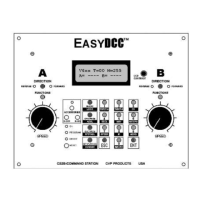28
Track Wiring Considerations
The wiring of layouts using EasyDCC is no different than with conventional power packs. As
long as your locomotive can traverse the layout without encountering any shorts, your EasyDCC
system will work just fine.
Booster Placement
If you only have one booster, placement can be anywhere. However, if you have a large layout
with multiple boosters, place the booster near the center of the area to be powered.
Track Wiring
Bus wires should be run underneath the track to be powered. Use #14 AWG wire or larger.
Stranded or solid does not matter although stranded bus wire is a little easier to handle. Feeders
between bus and track should be #18 or #20 AWG and attached every few feet.
Use at least #12 AWG for large scales such as O-gauge and LGB. #12 should be considered the
minimum size for the bus and #16-#18 should be used for feeders.
Power Zones and Rail Gaps
Adding extra boosters makes operation much easier in areas we call “center's of operation” such
as towns, yards, staging areas or complex industrial switching areas. Each booster is isolated
from adjacent boosters by gapping both rails in a convenient and logical location. Additional
suggestions for power zones and blocking can be found later in this section.
Proper Stripping Tool Makes Wiring Easier
A split jaw wire stripping tool makes mid-wire connections easy. Any large
hardware store will carry the stripper in their electical wiring department.
The image is of the one obtained at Lowes Hardware : Gardner Bender
Automatic Wire Stripper: Stock # 76050, Model: SE-92, about $15.
This tool has two pairs of jaws controlled by one handle. With the jaws
open, you can place the tool anywhere on a continuous run of cable. Then
squeeze the handles and watch what happens. The first set of jaws closes on
the wire to hold it firmly. The second set of jaws closes around the wire and
as you squeeze the handles, gently strips the insulation back leaving a
section of bare wire. Attach the feeder to the wire and you are done.
Solder Feeders To Track Sections
Model railroad sectional or flex track is not a good conductor of electricity. Using rail joiners to
electrically connect track sections is asking for trouble. We recommend that each section of flex
track be given its own feed. For short pieces, consider soldering the rails together.
Use only fresh rosin core solder. Old solder may not have any flux remaining (the rosin) making
it very difficult to solder with. Never use acid core solder - it will damage wiring and electronics.
Track Bus
Feeders

